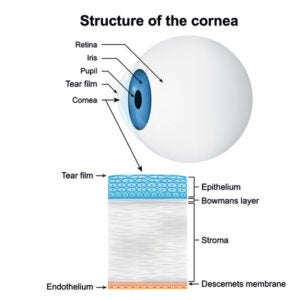Cornea Disease & Transplant Surgery in Southern NH
Cornea Center
While the cornea is surprisingly resilient, age or injury can lead to the development of corneal disease. We’ll discuss some of those issues and what the solutions are below. Visit Spindel Eye Associates for a full consultation and assessment.

What Is the Cornea?
The cornea is the clear, dome-shaped, highly complex tissue of your eye. It doesn’t have any blood vessels, so it pulls its nutrients from the fluid in the eye. The purpose of the cornea is to protect the rest of the eye from danger or disease. It also acts as a magnifying glass, focusing light onto the retina.
Common Corneal Conditions
Some of the common conditions we see at Spindel Eye Associates concerning corneas include the following:
- Corneal Abrasion: Corneal abrasions are scratches that are on just the surface of the eye. Small abrasions only penetrate the epithelium and heal quickly without damage to the rest of the eye or vision. Larger abrasions that cut below the Bowman’s layer usually leave scarring, which does affect vision.
- Fuchs Endothelial Corneal Dystrophy: Fuchs Endothelial Corneal Dystrophy is a condition where the corneal endothelium does not work properly. This dysfunction can cause thickening of the Descemet’s membrane and swelling of the cornea. This leads to a decrease in visual acuity and quality.
- Bullous Keratopathy: Bullous keratopathy is dysfunction of the corneal endothelium, caused by previous injury or surgery. The cornea swells, which causes a decrease in visual acuity and quality. In severe cases, the cornea can swell so much that it causes blisters on the epithelium, which is painful and increases the risk of infection.
- Keratoconus: Keratoconus is progressive corneal dystrophy. The cornea begins transforming from the normal dome-like shape to a cone-like shape. The cornea then bulges forward. This causes blurry vision and gets progressively worse.
Signs You May Have a Corneal Disorder
How do you know if you may have one of these corneal conditions? There are several symptoms that can help you to know when to make an appointment with our eye doctors at Spindel Eye Associates:
- Redness
- Blurred vision
- Light sensitivity
- Pain
- Foreign body sensation
One or two of these things on their own may not be a sign of concern, but when it comes to the eye, it’s always better to get it checked out sooner rather than later. Some of these conditions only get worse with time. At Spindel Eye Associates, we can provide you with a diagnosis and make sure you get the care that you need.
What Causes Corneal Disorders?
Many different things can cause corneal disorders. If any of these apply to you, you could be at higher risk:
- Genetics
- Eye trauma
- Infection
- Chronic inflammation
- Medication toxicity
- Dry eye
- Sun damage
- Eyelid problems
- Tumor
- Contact lens usage
- Ocular surgery
- Aging
Conditions and Procedures
While corneal conditions can be very serious, there are many procedures that can restore vision and health. The following procedures can help to rectify certain conditions.
- Corneal Abrasion: Most corneal abrasions can heal on their own without treatment. In more serious cases, a corneal transplant can be done to fix the abrasion.
- Fuchs Endothelial Corneal Dystrophy: In the early stages, there are some medications and self-care steps that can help alleviate the symptoms of Fuchs Endothelial Corneal Dystrophy. In later stages, the only way to restore vision is with cornea transplant surgery.
- Bullous Keratopathy: To treat bullous keratopathy, the following treatments are used:
- Salty eye drops and salt ointments draw excess fluid from the cornea
- Bandage contact lenses reduce discomfort
- Glaucoma medications reduce the pressure and flow of fluid into the cornea
- Keratoconus: Several things can be done to help ease the symptoms of keratoconus. Soft contact lenses can be used to correct the nearsightedness and astigmatism that comes in the early stages. As the condition progresses, other procedures and methods may need to be explored.
- Rigid Gas-Permeable Contact Lenses: These lenses correct vision for an irregular cornea by masking it with the smooth outer surface of the contact lens. These must be carefully fitted for each individual and require frequent check-ups to maintain good vision.
- Scleral Contact Lenses: These lenses have a larger diameter and cover the entire cornea. These must be carefully fitted, and frequent check-ups are required.
- Corneal Cross-Linking: UV light and eye drops are used to stiffen the cornea.
- Corneal Transplant: Some cases cannot be corrected by contact lenses. In these cases, a corneal transplant can repair the shape of the eye.
Contact Spindel Eye Associates
If you have a corneal disorder or need a diagnosis, contact us at Spindel Eye Associates. We can perform a comprehensive exam to check for corneal conditions, and our specialists can set you up with a treatment plan. Contact us today!
